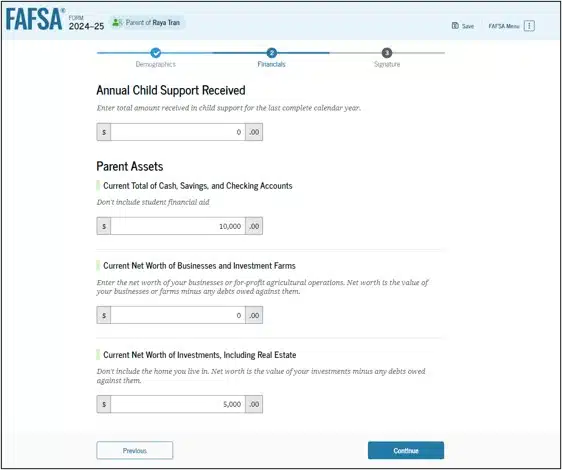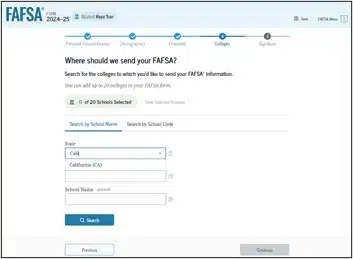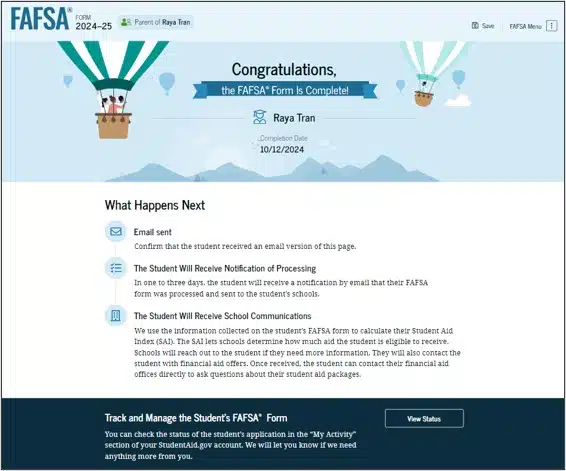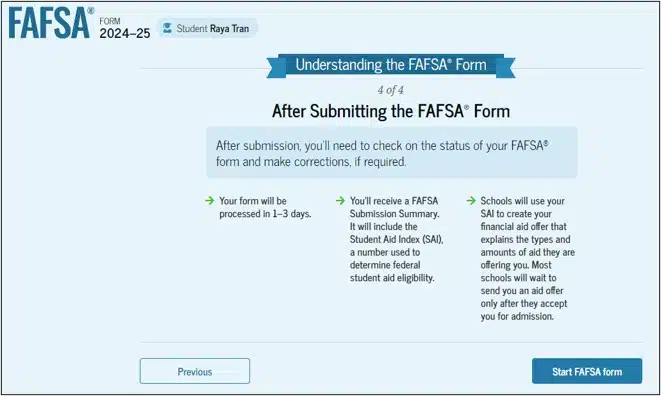This updated FAFSA guide for the 2025-26 academic year provides everything you need to complete the FAFSA and maximize your chances of receiving college financial aid.
The 2025-26 FAFSA form recently opened for all families, a shift bringing the timeline closer to the usual October 1 schedule after a major revamp in the last cycle. No major changes took effect this time around; instead, the Department of Education has refined the process based on feedback from the prior cycle.
Inside This Article:
- Step-by-step instructions
- Quick look at the FAFSA changes
- Who should apply for FAFSA?
- Who fills out the FAFSA form?
What Is FAFSA?
FAFSA, or the Free Application for Federal Student Aid, is a crucial form for students seeking financial assistance for college. It gathers information about the student’s and family’s finances to determine eligibility for grants, scholarships, and loans. You submit the form annually for each upcoming academic year.
As in previous years, when students and families fill out and submit the completed 2025-26 FAFSA, they’ll learn what types of aid they qualify for – and the portion of college costs their family will be responsible for. Also, note that FAFSA applies not only to colleges and universities but also to career schools and trade schools.
The biggest thing to remember is that the FAFSA is the gateway for many different forms of financial aid, and we recommend that every student submit a FAFSA. These different aid types include:
- Federal grants (e.g., the Pell Grant)
- Federal work-study programs
- Federal student loans
- State scholarships
- Need-based aid and some merit scholarships from colleges and universities

The 2025-26 FAFSA starting screen from the U.S. Department of Education.
Instructions on How to Fill Out the 2025-26 FAFSA
Filling out the 2025-26 FAFSA should take less than an hour if you’ve gathered the necessary information. Accuracy remains essential. This section outlines your steps.
Your questions will vary based on what type of FAFSA “contributor” you are. Contributors can be:
- The student
- The student’s spouse (for married students)
- Biological or adoptive parents
- Step-parent (parent’s spouse)
Step 1: Gather Your Information
- Personal information for parents and student, including Social Security number (or Alien Registration number) and driver’s license number if applicable.
- Personal information for contributors to invite them. This includes their name, DOB, Social Security number and email address. In your form, you list this information to trigger an invitation for them. Contributors do their own sections and must consent to the IRS data import.
- Your financial information, including tax returns; records of child support received; current balances of cash, savings, and checking accounts; and net worth of investments, businesses, and farms. (Each contributor lists applicable information for themselves.)
- The name or Federal School Code for each college the student is interested in. You can add others later, but listing possibilities now is good. You can list up to 20 colleges, double the number from previous years.
Step 2. Create Your FSA/FAFSA ID
You’ll need to create an FSA ID to access, complete and submit the FAFSA online. It also serves as your signature. Creating the ID before filling out the form can help you avoid any delays later, especially when you’re ready to submit.
To create your ID, go to the FSA ID page at StudentAid.gov.
The parent, student and other contributors must have their own FSA ID. Have your Social Security number, email address and mobile phone number ready.
Step 3. Fill Out the FAFSA Form
The application consists of seven sections and up to 36 questions, but some won’t apply to all contributors. Note that you can save the form at any point and return to complete it later. The government estimates the form takes an hour to complete.
You’ll fill out the following sections if they apply to you.
Personal Identifiers
You input identifying information such as:
- Your name, DOB, Social Security number and email
- Student (or parent) identity verification
- State of legal residence
- Contributor name, DOB, Social Security number and email to invite them as contributors. (Prompts to list contributors will also show up based on questions you answer.)
Note that a parent can log in under their own FSA ID to start a student’s form on their behalf or vice versa. That will trigger an invitation to the other person to log in under their own FSA ID.
Instructional Materials
The next screens show a video and slides explaining the new FAFSA process.
Consent
All contributors must click the consent button to allow the import of 2023 IRS tax data, or the application won’t be considered. This screen appears at different points for different contributors. But every contributor will get this screen and need to provide consent.
Student Personal Circumstances
This section asks a series of circumstance questions, including:
- Student marital status
- Student college plans
- Student special family circumstances
- Student dependency status
Demographics
You’ll answer questions about:
- Gender, race and ethnicity
- Citizenship status
- High school
- Parent marital status
- Parent state of legal residence
Your Finances
Students and parents fill this out separately.
- Information from your 2023 federal tax return
- Family size
- Account balances
- Value of assets

Select Colleges
Students can add up to 20 colleges to receive their information. You search for them by name or college code.

Step 4: Review, Sign and Submit Your FAFSA
Now you’re ready to review everything, sign and submit your form. You’ll get an email confirming receipt within a few minutes.

Step 5: Await Your Results Once All Contributors Have Submitted
Your FAFSA is complete until all contributors have signed and submitted it. The graphic below explains the timing.

Step 6: Get Your FAFSA Submission Summary
You’ll receive a FAFSA Submission Summary, which replaces the previous Student Aid Report. This shows your estimated aid and Student Aid Index (SAI). The SAI calculation differs from the Expected Family Contribution (EFC), prompting concerns that it may result in higher expected family contributions.
For example, the number of family members in college is no longer part of the calculation. Also, the SAI can now be a negative number, with a minimum SAI of -1,500 instead of zero.
Here’s a sample FAFSA Submission Summary from the Department of Education. It outlines aid eligibility and the SAI and provides a link to a more detailed page called the “Aid Summary.”

How to Get a Sneak Peek at Your Estimated Student Aid
The Department of Education offers a Federal Student Aid Estimator. One big caution is that your actual aid will vary from this estimate since it’s based on non-official information. Still, you may want to use it to get a ballpark estimate.
Quick Look at the FAFSA Changes
Sweeping changes arrived when the new FAFSA process was unveiled on Dec. 31, 2023. This overhaul included a simplified form, automatic tax data collection, new family contribution calculations, and changes for divorced parents.
Here’s a quick summary of the biggest FAFSA changes, which continue for the 2025-26 academic year cycle:
- Simplified FAFSA form: It now contains only 36 questions, down from more than 130. This streamlining is part of the FAFSA Simplification Act.
- Another delayed opening and tighter time frame: The 2025-26 FAFSA form became available Nov. 18, 2024. That’s earlier than last cycle, but still not back to the usual Oct. 1 opening date.
- Student Aid Index (SAI) instead of Expected Family Contribution (EFC): The Student Aid Index replaced EFC in the 2024-25 FAFSA and continues for 2025-26. As with last cycle, siblings will no longer get a financial advantage for being in school at the same time.
- Divorced parents: As with the last cycle, the parent who provides the most financial support has to file the FAFSA with their income and assets. In most cases, this makes the SAI much higher than if the custodial parent (who may have made much less) filed and reported – like they would have with previous years’ FAFSAs. It also includes spousal income for the remarried parent who makes the most.
- Automatic tax data collection: The government will again automatically collect your tax return data from the IRS for FAFSA purposes. That is a big change for last cycle. Previously, parents could import their tax data in the FAFSA form, but it didn’t happen automatically. Also, all people contributing to the FAFSA form must now consent to this IRS data collection. These “contributors” could include the student, the student’s spouse, biological or adoptive parents, or the step-parent (parent’s spouse). Being identified as a contributor doesn’t mean they’re financially responsible for the student’s education.
- Separate FSA IDs for each contributor: Each contributor needs their own FSA ID to access the form and complete their section. The FAFSA won’t be considered until all contributors have submitted their parts.
Who Should Apply for FAFSA?
All college applicants should submit the FAFSA, even if their families have million-dollar incomes. Why? FAFSA is the gateway to federal student and parent loans. Second, the calculation for need-based aid may surprise you. Third, FAFSA is used for some state and college scholarships and work-study programs.
“I truly believe everyone should file the FAFSA,” says college planning specialist Luanne Lee. “I’ve had clients that are seven-figure income earners, and we’ve filed the FAFSA for them. You just never know what’s going to happen.”
Bottom line: Fill out the FAFSA even if you think you won’t qualify for need-based aid. Even if you think you can cover every penny alone, having all the options available can’t hurt. And you don’t have to accept any aid you qualify for. It’s your choice.
What happens if you are no longer married to your child’s other parent? The FAFSA process can be a little complicated for divorced parents. There’s a change in the upcoming FAFSA cycle year due to the FAFSA Simplification Act. Under the new rules, where the student lives doesn’t determine who should fill out the FAFSA. The parent responsible for filling out the FAFSA is whoever provides more financial support to the child.
FAFSA Deadlines
We advise submitting the FAFSA as soon as possible because people who file earlier may receive more grant money than later filers. Also, many states and colleges have scholarship deadlines far earlier than the federal deadline, which is each June 30, the end of the academic year.
For example, FAFSA applications for the 2023-24 academic were due by June 30, 2024. They’re due by June 30, 2025, for the 2024-25 academic year. However, many state and college financial aid deadlines are much earlier than that. And, as we’ve said, it’s best to file as soon as possible when a new FAFSA cycle opens for the next academic year.
Financial Aid Deadlines for 2025-26 Academic Year
| School | Varies by school, with some as early as January 2025 |
| State | Varies by state, with some as early as January 2025 |
| Federal | June 30, 2026 (end of academic year) |
We recommend reading this guide and other resources to prepare for the changes and their possible effects on your situation.
Keep in mind many state grants rely on FAFSA. You’ll want to be among the first to apply for first-come, first-served money. Getting the FAFSA filled out right away is the best bet for accessing the most funds.
What happens if you miss the deadline? There’s not much you can do. So make sure to meet the deadline.
Who Fills Out the FAFSA Form?
The FAFSA form collects information about a student’s financial background and family situation to determine financial aid eligibility and the family’s expected contribution. Students and their families must input some information manually, but everyone’s tax data will be pulled automatically for the 2025-26 FAFSA, like it was last cycle.
In reality, many parents in past years have filled out the FAFSA for their children. However, both parent and student – and any other “contributors” to the form – will each need a unique Federal Student Aid ID (FSA ID) to sign in to the online portal, access the FAFSA, fill it out, and e-sign it. These “contributors” could include the student, the student’s spouse if married, biological or adoptive parents, or the step-parent (parent’s spouse).
Another option is for students to declare themselves independent, which is very difficult. (Read more about independent student status here.)
What Is a FAFSA ID?
The first step in filling out the FAFSA is obtaining an FSA ID, also called a FAFSA ID. Each person who contributes to the form must get one for themselves. You should not create an FSA ID and password for someone else. You’ll need to remember your ID and password for later use.
>> KEY LINK: GET YOUR FAFSA/FSA ID AT STUDENTAID.GOV
FAFSA Changes for Divorced Parents
With the new rules, the family’s contribution is based on the higher-income parent. Consequently, this could mean higher expected family contribution (now called Student Aid Index) than most previous scenarios.
That’s because the custodial parent, who may have earned significantly less, used to be the parent to file and report their income and assets on the FAFSA. Additionally, if the parent who contributes the most has remarried, the FAFSA includes the income and assets of the step-parent.
>> RELATED ARTICLE: FAFSA FOR DIVORCED PARENTS
Do You Have to Fill Out FAFSA Every Year?
Yes. Students should fill out a FAFSA form each year they’re in college. It ensures their consideration for financial aid (loans and scholarships). It also makes them eligible for certain college-based aid, like special department or athletic scholarships and work-study.
The government calculates eligibility for financial aid one year at a time. Fortunately, renewing the FAFSA is less time-consuming than filling out the initial application.
Use R2C Insights to Find Financial Aid
Road2College offers a college search and comparison tool called R2C Insights. Try it for free to see which colleges provide the most financial aid for your situation. We offer a free version to get started and a premium version to go deeper.
R2C Insights has data on which colleges require only the FAFSA and which colleges require the FAFSA and the CSS Profile. This information can be helpful for divorced families and families with low income but high retirement assets (since the FAFSA does not include assets in qualified retirement accounts). Insights users can identify schools that only require FAFSA.
Depending on your financial situation, some families should consider having their student apply to at least one or more of these schools.
FAFSA FAQ
My Income Is So Different From the IRS Data Being Imported for FAFSA. What Can I Do?
Contact the school to explain your special circumstances. Sometimes the prior-year tax return is not an accurate representation of your finances. If so, you’ll still fill out the FAFSA according to the directions.
However, you can then contact the schools your student focuses on and let them know your special circumstances. They may be able to adjust their financial aid award before they send it out.
What Can We Do if The Aid Award Isn’t Enough?
Families often find that the aid doesn’t meet their full needs. Even if you do have a school meet your student’s full need, you might find that your EFC/SAI is more than you have saved.
If you feel that your student deserves a better award, they may want to appeal the financial aid award. Beyond an appeal, many families turn to private student loans or private parent loans. When you compare lenders, look for specific features. These include various repayment terms, pre-qualification availability, the option to remove a cosigner from a private student loan, a choice of loan duration, and more.
Is the FAFSA Form Free?
Yes, the FAFSA is always free.
Writer Linsey Knerl contributed to this article.




